Jim Beam Vs Jack Daniels: Who Makes The Better Whiskey?
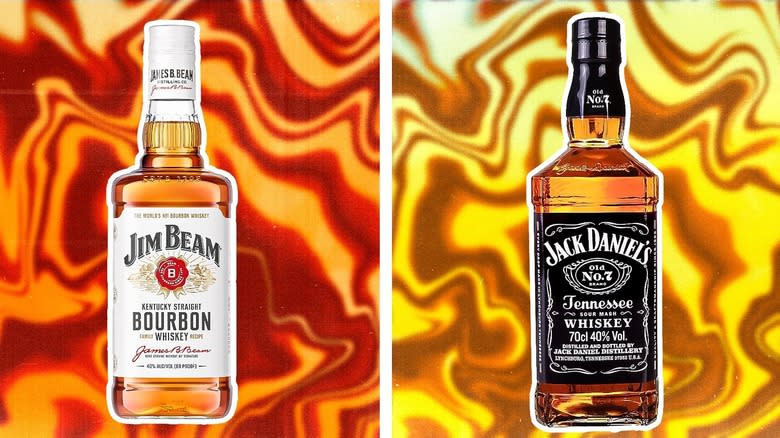
When it comes to American whiskey, no two brands are more iconic than Jim Beam and Jack Daniel's. Both enjoy a sizable market share, enjoyed by millions of Americans and spirit lovers worldwide. The popularity of these two brands is one similarity between them, but away from the sales and reputation, there are some significant differences. One is Kentucky whiskey, while the other hails from Tennessee. One markets itself as bourbon, while the other shies away from using such a label.
These are just two of the many differences between these iconic whiskeys. Here, we'll delve into every aspect of what makes Jim Beam and Jack Daniel's distinct from each other. To do this, we'll use our own experience with the lineups of each brand to give you all the information you're looking for. Along the way, we'll also look at the mash bills, distillation process, aging techniques, range of expressions, and much more. Ultimately, we'll answer the key question of which distillery makes the better whiskey.
Read more: The 25 Best Bourbon Brands, Ranked
History Of Jim Beam
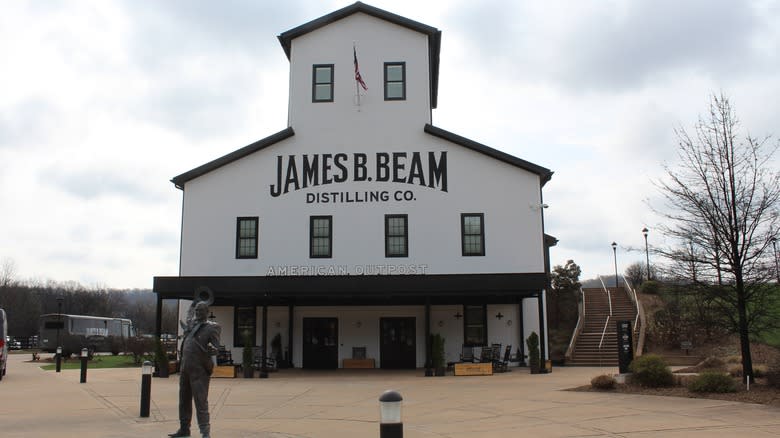
The story of Jim Beam starts over two centuries ago, making it almost as old as America itself. Back in 1795, a farmer and grain mill operator named Jacob Beam decided to sell the bourbon he made from the corn he'd been growing. The distillery's growth continued due to local popularity, and in 1820, his son David Beam helped the company progress. The bourbon-making process became more professional and standardized using column stills and charred barrels. David Beam also used the new railroad to help distribute his whiskey nationwide.
Over the next century, the whiskey (sold under the name Old Tub) continued increasing in popularity as one of the first nationally recognized bourbon brands. In 1884, James "Jim" Beam took over the distillery. However, not long after the 20th century came along, prohibition hit the industry hard in 1920. Once prohibition was repealed in 1933, Jim Beam quickly rebuilt the distillery and started selling his bourbon under the name of Colonel James B. Beam Bourbon. His son, T. Jeremiah, took over the distillery in 1935 and, in honor of his father, renamed the distillery the Jim B. Beam Distilling Company. Through innovative ideas such as shipping to American troops overseas and focusing on small-batch bourbon, the company played a pivotal role in the rising global popularity of this fine spirit.
History Of Jack Daniel's
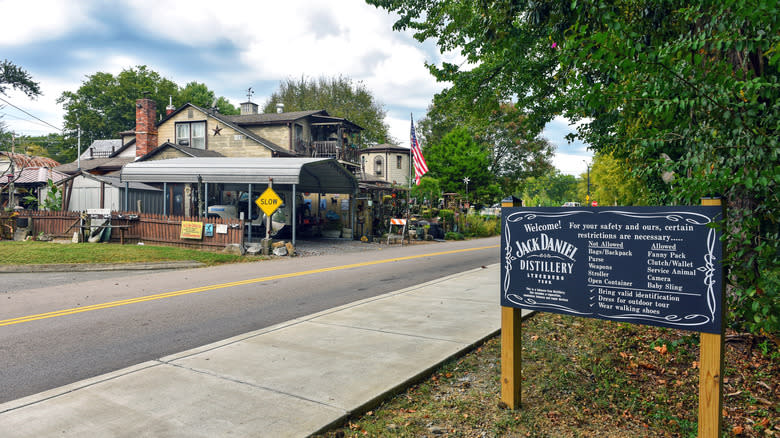
The story of Jack Daniel's starts nearly 70 years after that of Jim Beam but it's no less interesting. Jasper Newton "Jack" Daniel was taken in by a preacher and distiller named Dan Call when he was just a teenager. Under Call and an enslaved man named Nathan "Nearest" Green, Daniel learned the art of whiskey-making. Still a young man (his exact birthdate is unknown), Daniel officially founded his distillery and employed the now-freed Nearest as his Head Distiller. After suffering from sepsis for many years, Daniel eventually passed away in 1911, leaving the distillery to Lem Motlow, his nephew.
Of course, not long after Motlow took over, the distillery had to close down due to prohibition. However, it wasn't the only time Jack Daniel's needed to close its doors as World War II also led to a halt in production. After the end of the war, the distillery soon flourished, and soared to new heights after an endorsement by Frank Sinatra in 1956. It started an association with music that still thrives to this day. In modern times, Jack Daniel's has built on its iconic No. 7 whiskey and created plenty of other varieties that have further added to its global appeal.
How Is Jim Beam Made?
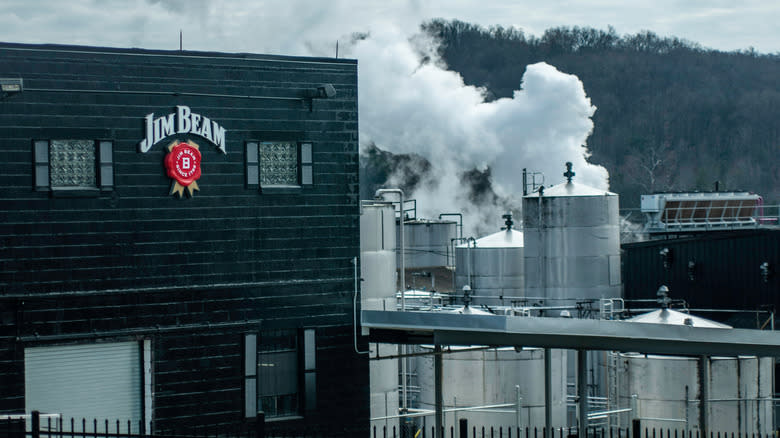
Jim Beam has a meticulous production process that contributes to its distinctive flavor profile. It all starts with a mix of high-quality ingredients that meet the brand's high standards. These ingredients are then cooked in Kentucky's famous limestone-filtered water that helps give it that slightly sweet taste. Jim Beam uses its unique yeast strain to ferment the mash bill and starts to create that fine spirit. After fermentation, the mix is sent to its column stills to distill the bourbon.
This method allows for a continuous and consistent production process. At around 200 degrees Fahrenheit, the vapor will separate from the base ingredients, giving the first signs of a drinkable liquid. Following this, the liquid is sent into the doubler for a second distillation before it eventually comes out just under 160 proof to be barreled. In truth, there is nothing especially unique about how Jim Beam produces its whiskey. Instead, it has a commitment to perfecting the age-old process to produce a bourbon you can rely on.
How Is Jack Daniel's Made?
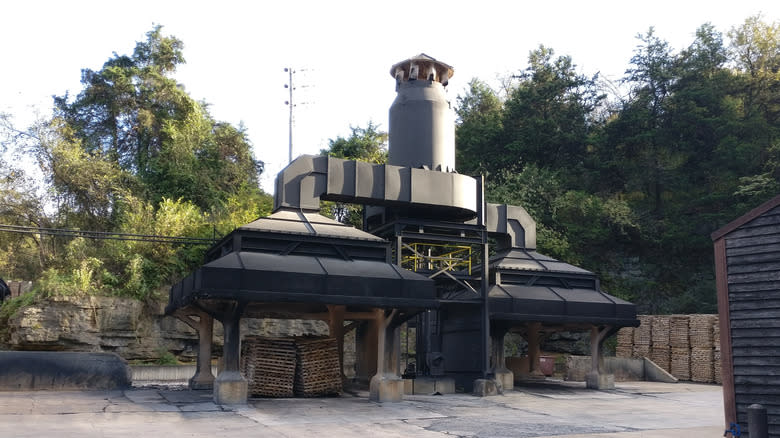
As with Jim Beam, the water used to make Jack Daniel's has been significantly influenced by limestone. In the case of Jack Daniel's it comes from limestone spring water in a cave that sits two miles underground. The brand bought the cave and its surrounding land, mainly because the water inside was incredibly pure, without any sediment or impurities. Its distillation process is similar to Jim Beam's but with one big difference — Jack Daniel's uses a large copper still, distilling its spirit just once to get the final product.
However, the most unique aspect of the Jack Daniel's process is what happens after distillation. Commonly called the "Lincoln Country Process," the distillery sends its newly-created whiskey through 10 feet of bespoke charcoal, created from whiskey-doused sugar maple. Powered by gravity, this process takes 3-5 days and plays a hugely significant role in the mellowing and smoothness associated with Jack Daniel's. Its use of its own water and charcoal results in a whiskey that's impossible to replicate.
Ingredients And Mash Bills
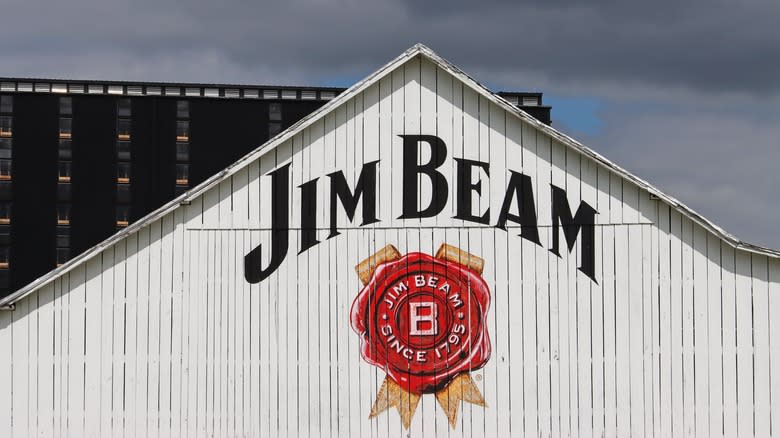
In terms of their raw ingredients, these two whiskeys are remarkably similar. Both use a combination of corn, rye, and barley in the mash bill. The corn is a high percentage for both brands, with Jim Beam using 75% corn and Jack Daniel's 80%. Jim Beam's use of the other two ingredients is almost equal, with rye at 13% and barley at 12%. Interestingly, Jack Daniel's uses the same percentage of barley but due to the higher level of corn, the use of rye is at just 8%. For a few of its other brands, such as Old GrandDad and Basil Hayden's, Jim Beam uses much more rye with a mash bill of 63% corn, 27% rye, and 10% barley.
With the core expressions of the two distilleries having very similar mash bills, it would be easy to assume these two whiskeys would taste very similar. However, many factors affect the taste of bourbon, and as we've just seen, the processes are quite different. It all adds up to Jim Beam leaning towards a bolder and spicier profile, while Jack Daniel's is more mellow and sweet. Another interesting fact is that with its high corn content, Jack Daniel's meets all the legal requirements for being called a bourbon. However, it doesn't like you calling it one — even though that's technically what it is!
Aging Techniques
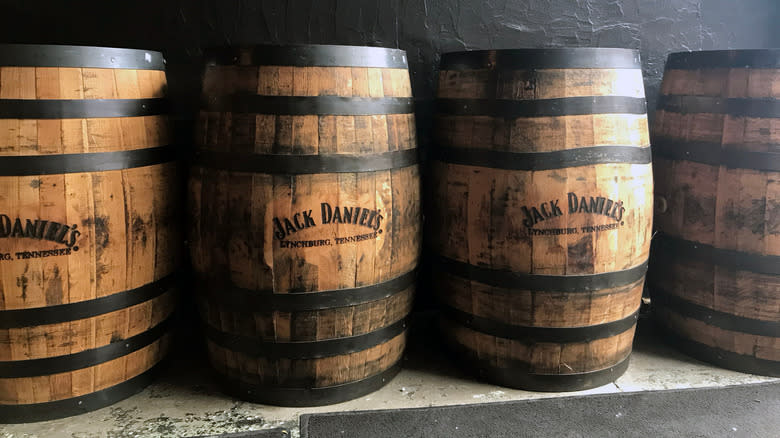
Perhaps the most significant factor when it comes to the final taste of whiskey is how the spirit is stored and aged. Both distilleries adhere to time-honored methods, yet variations in the approaches result in unique profiles. For Jim Beam, this involves its whiskey being sent into new American White Oak barrels that have received a level-4 charring. This char level helps caramelize the sugars in the wood to give the bourbon a sweeter flavor while also reducing the level of tannins. Too much tannin influence can give the final product an intense oak taste if left unchecked. The final stage is sending the barrels into one of its rackhouses. We say one of, as Jim Beam's owner, Beam Suntory, has an incredible 112 rackhouses in Kentucky.
As with Jim Beam (and almost every American whiskey brand), Jack Daniel's uses American White Oak for its handcrafted barrels. And similarly, these barrels are charred and used once before being sold. The distillery uses barrelhouses to store its whiskey, and while not quite as many as Jim Beam, it does have an impressive 92 of these facilities. With the whiskey being stored at different levels, the spirit isn't kept for a specific time. Instead, it's bottled when ready and meets the Master Taster's expected quality. These nuanced differences in aging techniques contribute to the distinctive flavor profiles of Jim Beam and Jack Daniels, showcasing the impact of craftsmanship and regional traditions on the final product.
Signature Products
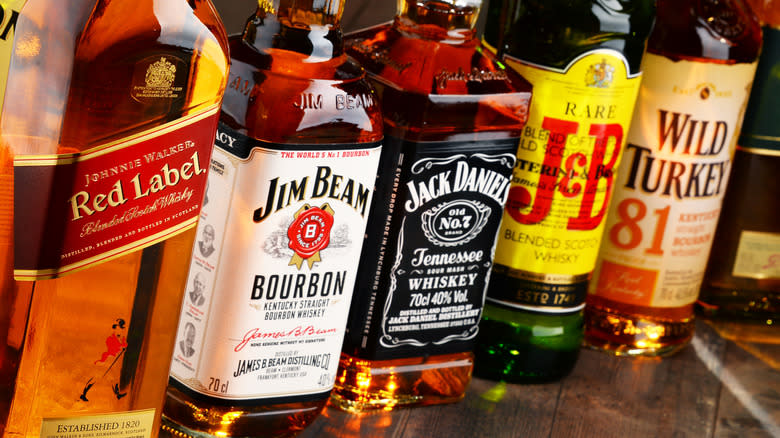
Both of these brands now boast a huge range of expressions, including flavored whiskey, liqueurs, mature-aged whiskey, and cask-strength products. However, both have built their reputations off the back of iconic signature products. Jim Beam's most famous expression is its Kentucky Straight Bourbon, often affectionately called the "White Label." It's known for having a classic bourbon flavor profile and makes for a great introduction to Jim Beam bourbon before you explore some of the other popular expressions, such as Devil's Cut and Red Stag.
Of course, Jack Daniel's has a no less famous expression. Its Old No. 7 is known around the world. Also commonly called "Black Label," it's the cornerstone of the brand and has become a cultural icon. This Tennessee whiskey is characterized by its smoothness, achieved through the unique charcoal mellowing process. The slightly sweet and mellow profile of Old No. 7 has become synonymous with Jack Daniels. Other expressions, such as Gentleman Jack, enjoy a high level of popularity, but it's not on the same level as the Old No. 7. While far from the distillery's only expressions, Jim Beam White Label and Jack Daniel's Black Label are the perfect examples of the differences between these great whiskey manufacturers.
Varieties And Limited Editions
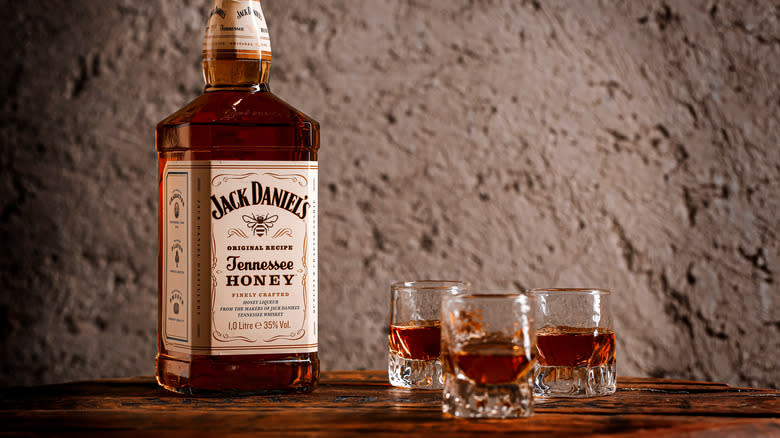
Any journey into these two brands must start with the most famous expressions. However, beyond that, there's a whole world to explore. It's worth noting that James B. Beam Distilling Company also owns several other bourbon brands, such as Knob Creek, Basil Hayden, Booker's, and Old Grand-Dad. It's a great idea to check those out, but here, we'll focus on those varieties under the Jim Beam brand. A similarity both Jack Daniel's and Jim Beam share is a wide range of flavored whiskey. For Jim Beam, this includes apple, vanilla, honey, and black cherry (under the name of Red Stag). For Jack Daniel's, we get honey and apple. Added to these expressions, both brands produce a "Fire" whiskey for those who love the taste of cinnamon.
There are other similarities, too, with both having a single-barrel whiskey. While Jim Beam's is bottled at 108 proof, Jack Daniel's has four versions: Select, Rye, Barrel Strength, and 100 Proof. Even though Jack Daniel's has a single-barrel version, both distilleries produce regular high-rye whiskey. Beyond the current lineups, both distilleries have a great range of limited editions, such as the Master Distiller Series from Jack Daniel's and its age-statement whiskeys. On the other side, some of the best varieties from Jim Beam include the Double Oak, which is twice barreled, and the Black, which is extra aged. Exploring these varieties is a great way to appreciate how the taste of whiskey can change with different flavorings, barreling, and maturation.
Tasting Notes And Flavor Profiles
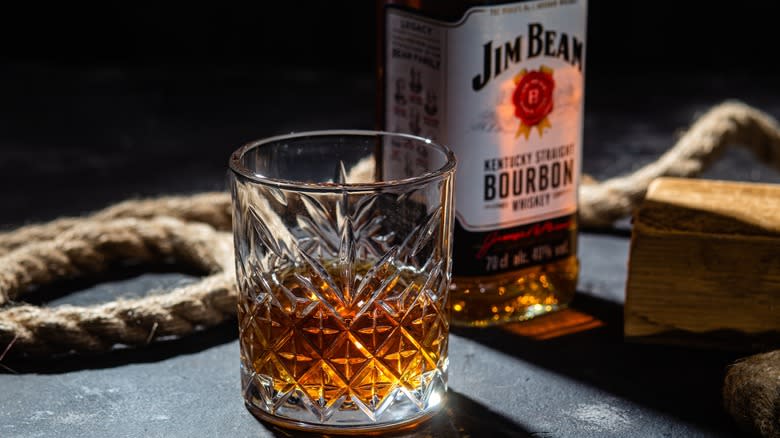
Even though these two brands offer a vast range of expressions, both have distinctive flavor profiles that run through almost all of the whiskeys. The flavor of Jim Beam perfectly represents its bourbon lineage. The flagship White Label boasts an impressive harmony of classic bourbon tasting notes that include vanilla, caramel, and spice. This serves as a benchmark for the brand, and those flavors, along with its oaky undertone, can be found throughout its expressions. For those who want to know what bourbon is meant to taste like, the White Label is a great place to start before you move on to its other varieties.
In comparison, Jack Daniels, as a Tennessee whiskey, introduces a smoother and slightly sweeter flavor profile. The Lincoln County Process mentioned plays a huge role in this, giving the spirit a balance of sweet corn, mellow oak, and a touch of fruitiness. Added to this, the charcoal influence also gives it a subtle smokiness. The single-barrel offering from both brands is a perfect option for those who want to explore these tasting notes but in a more premium and maturely crafted bottle. Both brands share common elements such as notes of vanilla and caramel, but beyond this, there are plenty of nuances that set these brands apart.
Cultural Influence And Popularity
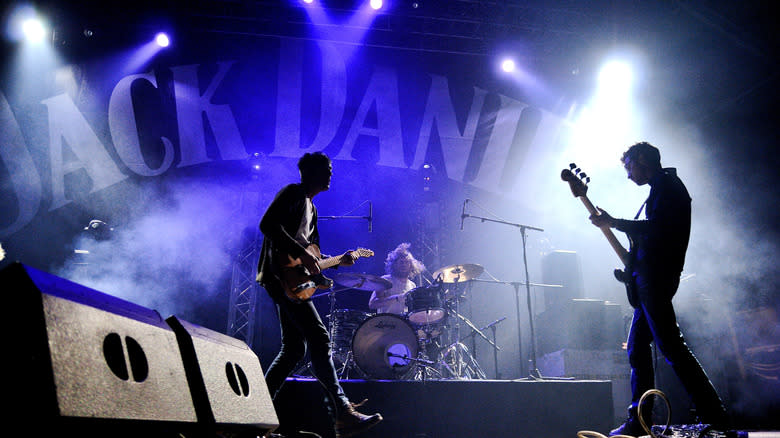
Most alcohol brands could only dream of having the popularity of Jim Beam or Jack Daniel's. The influence of these American whiskey brands goes way beyond that of whiskey connoisseurs and intertwines with the cultural fabric of American spirits. As we've seen, Jim Beam has a heritage going back to the 18th century. The brand has become synonymous with bourbon tradition throughout its history, and its cultural impact has been profound. From its presence in country music to its association with the Kentucky Derby, there's little doubt that Jim Beam has become an ingrained part of American culture.
Of course, Jack Daniel's takes this cultural influence to the next level. The brand has a global following and a strong association with rock and roll legends, helped by its iconic black label. This cultural influence has become a staple of concerts and festivals, with its logo commonly adorning stages and merchandise, particularly clothing. It's fair to say that both distilleries have transcended the boundaries of a traditional spirit. Both have influenced popular culture in a way neither most likely ever thought possible. As a side benefit, these brands have helped make whiskey cool, which has undoubtedly helped the whiskey industry as a whole.
Price And Accessibility
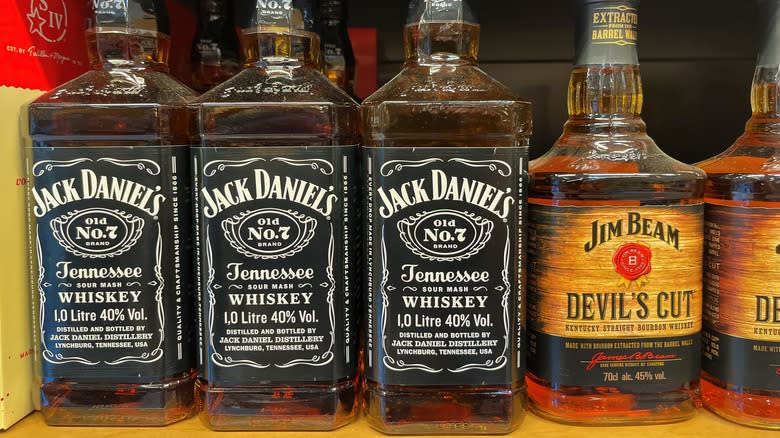
When it comes to the battle of Jim Beam vs Jack Daniel's, price and accessibility have played a pivotal role in the success of each brand. Jim Beam has a broad portfolio of bourbons that encompass a range of price points but are known for offering exceptional value for money. The Jim Beam Kentucky Straight Bourbon, especially, is an entry-level bourbon that ensures anyone can enjoy Kentucky craftsmanship without breaking the bank. This affordability has made Jim Beam a staple in many households and bars. Getting a better bourbon at the White Label's price point is almost impossible.
In contrast, Jack Daniel's falls into a slightly higher price bracket than Jim Beam for its entry-level expressions. Crucially though, Jack Daniel's is still highly affordable and is usually cheaper than many other popular whiskey brands like Wild Turkey, Maker's Mark, and Woodford Reserve. This means these brands have whiskeys that are low-cost and highly accessible, making both a great place to start if you want to try whiskey. However, if you're on a low budget and trying to decide between these two brands, Jim Beam is the winner.
The Verdict: Which Is Better?
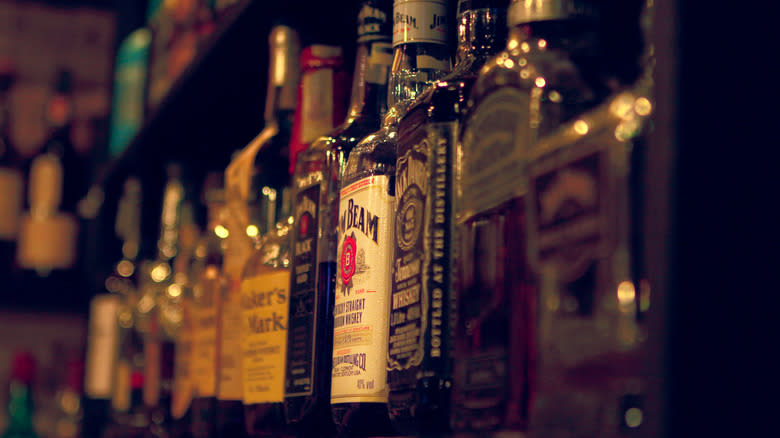
The comparison between Jack Daniel's and Jim Beam often boils down to personal preference. Both are iconic whiskey brands but if you have their expressions side-by-side, you'll soon see the distinct characteristics that set these two apart. We would say that whiskeys from Jack Daniel's are better if you want a smooth and mellow flavor. The flagship Old No. 7 is a great example of that, but all of its whiskeys are easy to drink, which helps to make it popular with casual whiskey drinkers. Many people would swear that Jack makes the better whiskey, whether that's sipping or in cocktails like a whiskey sour.
However, bourbon lovers would heartily disagree. Jim Beam is a quintessential bourbon, and if you crave its rich and robust flavor profile, it could be the drink for you. It's made traditionally and is a great entry point if you want to start exploring bourbon. Ultimately, having a glass of both is the best way to decide. And once you try the iconic White and Black Label bottles, you can enjoy further exploring the huge range of expressions these two distilleries offer.
Read the original article on Tasting Table.

